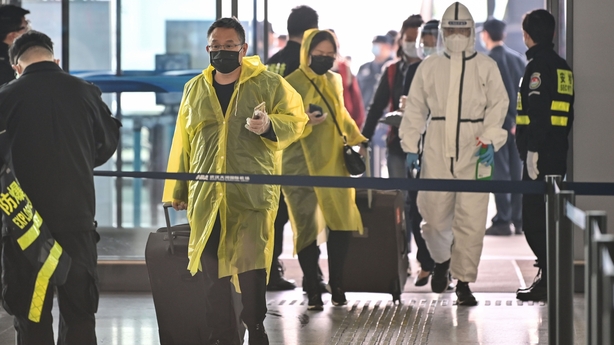The Chinese city where the coronavirus epidemic first broke out, Wuhan, has ended a two-month lockdown.
However, a northern town has started restricting the movement of its residents amid concerns of a second wave of infections in mainland China.
China sealed off Wuhan, a city of 11 million people, on 23 January to stop the spread of the virus.
More than 50,000 people in the city caught the virus, and at least 2,500 of them died, about 80% of all deaths in China, according to official figures.
Restrictions have eased in recent days as the capital of Hubei province saw just three new confirmed infections in the past 21 days and only two new infections in the past fortnight.
But even as people leave the city, new imported cases in the northern province of Heilongjiang surged to a daily high of 25.
It has been fuelled by a continued influx of infected travellers arriving from Russia, which shares a land border with the province.
We need your consent to load this rte-player contentWe use rte-player to manage extra content that can set cookies on your device and collect data about your activity. Please review their details and accept them to load the content.Manage Preferences
Suifenhe City in Heilongjiang restricted the movement of its citizens today in a similar fashion to that of Wuhan.
In Jiaozhou City, in the eastern province of Shandong, the risk level had risen from low to medium, according to a post on an official website, but it gave no details why.
Around 55,000 people are expected to leave Wuhan by train today.
More than 10,000 travellers have left the city by plane so far as flights resume at Wuhan Tianhe airport.
Flights to Beijing and international locations have not been restored.

Wuhan residents have been urged not to leave their neighbourhood, their city and even the province unless absolutely necessary.
People from Wuhan arriving in Beijing will have to undergo two rounds of testing for the virus.
Asymptomatic patients and imported infections have become China's chief concern.
In the US, New York was one of several states, along with the nation as a whole, to post their highest daily loss of life from Covid-19 with 731 deaths in New York State alone.
In Wisconsin, voters braved the coronavirus outbreak to wait two metres apart in lines for hours and cast ballots in the state's presidential primary and local elections.
For the United States, the tally of known coronavirus infections approached 400,000 yesterday, with the number of deaths surpassing 12,700 in a record single-day jump of more than 1,800 nationwide.
European countries have recorded more than 600,000 cases of Covid-19, according to the European Centre for Disease Prevention and Control.
Officials have reported more than 51,000 deaths, most of them in Italy and Spain.
Lockdowns have been introduced to varying degrees across the bloc, ranging from enforced stay-at-home orders in places such as northern Italy to far less restrictive advice in Sweden, where people have been allowed to gather in small numbers and freely move about.
EU leaders are becoming increasingly alarmed at the economic damage wreaked by the lockdowns. France has warned it is facing the deepest recession since the end of World War II.
The EU's top scientist has resigned after failing to persuade Brussels to set up a large-scale scientific programme to fight Covid-19.
The President of the European Research Council, Professor Mauro Ferrari, said he had been "extremely disappointed by the European response to Covid-19".
He lamented "the complete absence of co-ordination of healthcare policies among member states, the recurrent opposition to cohesive financial support initiatives, and the pervasive one-sided border closures" in the EU.
Professor Ferrari now plans to set up an international research initiative to fight Covid-19 from the US.

